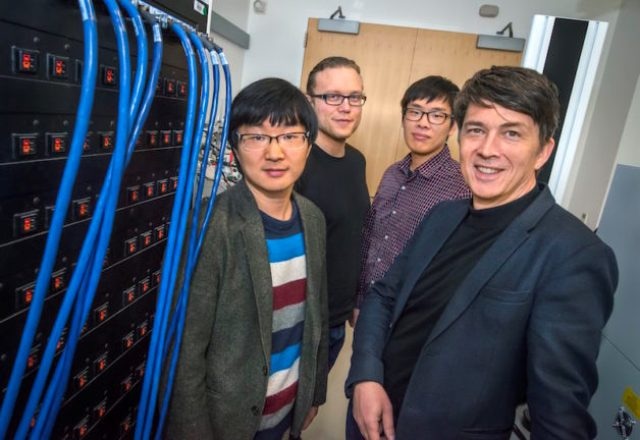May 31 2016
“Lithium-rich” cathode, which contains more lithium than the usual cathode, is the new material of interest for developing a better lithium-ion battery. Though this battery has higher energy density, researchers do not have a clear idea about the chemical process involved, particularly about the role of oxygen.
 A new study by Berkeley Lab researchers Dong-Hwa Seo, Alex Urban, Jinhyuk Lee, and Gerd Ceder (from left) sheds light on how lithium-rich cathodes work, opening the door to higher capacity batteries. (Credit: Roy Kaltschmidt/Berkeley Lab)
A new study by Berkeley Lab researchers Dong-Hwa Seo, Alex Urban, Jinhyuk Lee, and Gerd Ceder (from left) sheds light on how lithium-rich cathodes work, opening the door to higher capacity batteries. (Credit: Roy Kaltschmidt/Berkeley Lab)
A significant advancement in understanding the mechanism by which oxygen oxidation forms additional capacity in lithium rich cathodes has been reported by scientists at the Department of Energy’s (DOE) Lawrence Berkeley National Laboratory (Berkeley Lab). This advancement could pave the way for batteries with a higher energy density, which means electric devices would be able to run longer between charges.
“The specific nature of our findings shows a clear and exciting path forward to create the next-generation cathode materials with substantially higher energy density then current cathode materials,” the scientists have described in their study entitled, “The structural and chemical origin of the oxygen redox activity in layered and cation-disordered Li-excess cathode materials,” published in Nature Chemistry journal.
Gerbrand Ceder of Berkeley Lab’s Materials Sciences Division initiated this research. Dong-Hwa Seo and Jinhyuk Lee were the lead authors, and Alexander Urban, Rahul Malik, and ShinYoung Kang were the other co-authors. Ceder is also appointed at UC Berkeley’s Department of Materials Science and Engineering, and all the co-authors are also affiliated with the Massachusetts Institute of Technology (MIT), where a part of the work was performed.
The cathode in a traditional lithium-ion battery is a lithium transition metal oxide with a balanced content of lithium and the transition metal like cobalt or nickel. There is motr lithium when compared to the transition metal in lithium rich or lithium excess cathodes. Decreasing the content of transition metals is beneficial as they are heavy and expensive. The battery would be much more economical and lighter which are significant factors for their usage in vehicles as batteries are usually the heaviest components in the vehicle.
This is a very exciting direction being pursued by battery scientists. It has been experimentally demonstrated many times that a lithium-excess cathode material can deliver higher energy density, about 50 percent higher than the current cathode materials in commercial lithium batteries.
Jinhyuk Lee, Berkeley Lab
However, the lack of clarity in the mechanism involved in a lithium rich cathode is the major drawback. The cathode’s transition metal oxidizes and releases electrons which travel between the anode and cathode and generate electricity when a battery undergoes charging and discharging.
“What we and others have been claiming recently is that you can take an electron off the oxygen and put it back, which is fairly radical. That’s the big idea for this cathode design,” Ceder said. “This paper specifically shows that it’s true and more importantly, shows under which conditions that it becomes true.”
Ceder said that he and his colleagues have been pondering over the role of oxygen in cathode for over 15 years. “It was highly controversial,” he said. “We knew it was there. This study is a big conceptual breakthrough for us.”
Cobalt, nickel, and manganese are currently the only three transition metals used in most of the commercial cathodes. This limitation in choice constrains the design of battery. Another drawback is that the availability of transition metals is also limited. There is an increased demand for cobalt as above 45% of the world’s cobalt production is used for lithium ion batteries production, explained Ceder.
It’s not scalable. If we’re ever to all drive electric vehicles, there’s no way a cobalt-only technology can make it.
Gerbrand Ceder, Berkeley Lab
This study was initiated two years back after Ceder’s team found that a “disordered” cathode structure, which was earlier dismissed by battery designers, may actually work. This motivated the group to check when and how oxygen is active in lithium-excess cathodes, which are structurally similar to the disordered cathodes.
A novel methodology was developed by Ceder and his team to study electron charge transfer in cathode materials by using quantum mechanical simulations with high accuracy. The researchers utilized supercomputer facilities at the National Energy Research Scientific Computing Center (NERSC), a DOE Office of Science User Facility hosted at Berkeley Lab, and the Extreme Science and Engineering Discovery Environment (XSEDE), headed by the University of Illinois.
This discovery would permit researchers to approach the design of batteries in a more rational way.
Now we understand how the oxygen is oxidized and how it competes with transition metals in oxidation. We now know how to manipulate transition metal and oxygen oxidation to achieve higher energy density cathodes.
Dong-Hwa Seo, Berkeley Lab
It will also offer them other options. “We can now use 15 or 20 different transition metals,” said Ceder. “We can use a much broader range of chemistry to look for cathodes, and we know exactly the kind of structures we want to engineer.”
DOE’s Office of Vehicle Technologies, the Robert Bosch Corporation, and Umicore Specialty Oxides and Chemicals funded this study.